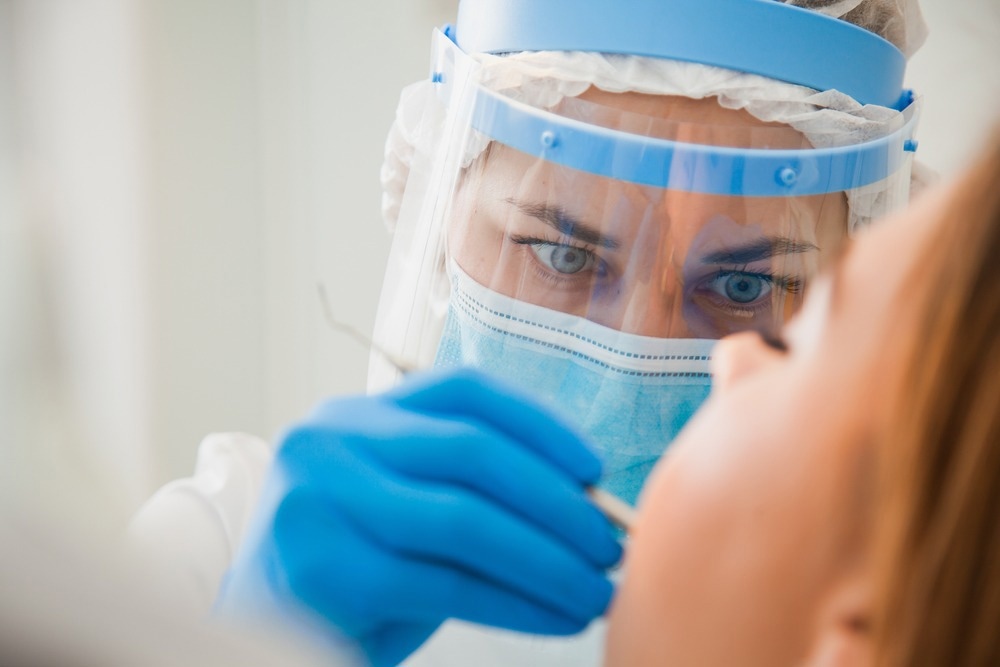Tooth staining and oral infections are caused due to formation of pathogenic biofilms and microbial colonization. Effective preventive measures or curing therapies in dentistry to overcome these issues are limited.

Study: Copper Doped Carbon Dots for Addressing Bacterial Biofilm Formation, Wound Infection, and Tooth Staining. Image Credit: klyots/Shutterstock.com
In an article recently published in the journal ACS Nano, researchers reported that copper-doped carbon dots (Cu-CDs) could prevent the primary bacterial adhesion and eradicate the microbial biofilm formation in oral tissue via the generation of reactive oxygen species (ROS) and oxygen (O2).
Infectious Diseases in Human Oral Cavity
The human oral cavity houses different bacterial species forming a bacterial environment. Few bacteria form a pathogenic biofilm in oral tissues through various biological processes and biochemical reactions. On the other hand, the biofilm’s dormant bacteria may cause the reoccurrence of chronic infections locally. The exogenous tooth stains caused by various drinks may undergo browning between proteins and carbohydrates and retain the chromophore.
Although several traditional treatments, including root canal treatment, antibacterial drugs, and dental implants could treat oral infections, these methods require professional assistance and do not eliminate the microbial biofilm. Additionally, invasive bleaching strategies come with many side effects. To this end, ROS-based chemical whitening is a promising strategy that oxidizes the colored chromogens into colorless small molecules.
Cu-CDs Addressing the Oral Infection Issues
In the present study, the researchers designed and synthesized Cu-CDs with biofilm eradication, bactericidal, whitening, and wound healing activities for treating oral infections. The as-prepared Cu-CDs had peroxidase-like (POD-like) and catalase-like (CAT-like) activities, enhancing ROS and O2 production in the oral cavity.
The Cu-CDs had a strong binding affinity to lipopolysaccharide (LPS), and peptidoglycan (PGN), which ensured effective capture and increased local dose to exhibit excellent antibacterial activity against Staphylococcus aureus, Streptococcus mutans, and Escherichia coli.
On testing the efficacy of Cu-CDs on mouse models, the team found that the Cu-CDs can remove the Streptococcus mutans biofilm via dual functions of physical oxygen power and chemical ROS generation. Furthermore, the as-prepared Cu-CDs as nano-mouthwash eliminated bacteria and destroyed the biofilm under slightly acidic conditions, and oxidized the chromogen, resulting in teeth whitening.
The researchers demonstrated that the local exposure of Cu-CDs nanoenzymes to the human oral microenvironment could prevent further pathogenesis of oral infectious diseases and consequent teeth staining.
Research Findings
Transmission electron microscopy (TEM) images confirmed the successful synthesis of spherical homogenous Cu-CDs with a particle size of 4.50 nanometers. The atomic force microscopy (AFM) images showed the surface topology, and Cu-CDs exhibited a rough morphology with an average height of 1.48 nanometers.
Raman spectra revealed the hybridization state of carbon. The disordered and sp2 hybridized carbon atoms showed peaks at 1395 and 1622-centimeter inverse, respectively. The zeta potential of CDs changed from -25.4 millivolts to -28.3 millivolts in Cu-CDs.
The Fourier transform infrared (FTIR) revealed the chemical bonds in Cu-CDs. The absorption peaks at 3423, 3158, 1675, and 1388-centimeter inverse corresponds to the stretching vibrations of hydroxyl (OH) or amine (N-H), O-H, carbonyl (C=O), amine (C-N) groups, respectively. The presence of the aforementioned hydrophilic groups in Cu-CDs offered them good stability in the water environment.
The X-ray photoelectron spectroscopy (XPS) technology confirmed the elemental composition of Cu-CDs and CDs along with their chemical states. The spectra revealed the peaks of carbon (C) 1s, oxygen (O) 1s, nitrogen (N) 1s, and Cu 2p with the atomic percentages of 40.06%, 14.65%, 5.41%, and 0.53%, respectively.
Owing to the nanozyme activities, the antibacterial activity of Cu-CDs was evaluated against Staphylococcus aureus, Streptococcus mutans, and Escherichia coli through the viable cell counting method. The researchers found that exposure of the bacterial culture to Cu-CDs at a concentration of 80 micrograms per milliliter for 24 hours killed almost 99% of Escherichia coli and Streptococcus mutans; in other words, the minimum bactericidal concentration (MBC) of Cu-CDs is 80 micrograms per milliliter. On the other hand, Staphylococcus aureus required 120 micrograms per milliliter for 100% inhibition.
The Cu-CDs induce Fenton reaction and produce ROS required for antibacterial activity. The high ROS levels in Cu-CD nanozymes caused breakage of the bacterial cell membrane and consequently damaged the subcellular components, including proteins and DNA, ultimately leading to bacterial death.
Conclusion
In conclusion, the researchers synthesized enzyme-powered, biomaterial-based Cu-CDs for antibiofilm, anti-oral pathogens, stained tooth whitening, and infection-induced wound healing. The CAT-like and POD-like activities of Cu-CDs produced high O2 and ROS, which exhibited antibacterial activity.
The binding forces between Cu-CDs and bacteria cell wall-derived LPS or PGN significantly promoted the antibacterial activity resulting in the dissociation of bacterial biofilm through the catalytic activity of Cu-CDs.
The Cu-CDs eradicated the infection-induced wounds and promoted wound healing by anti-infection activity and stimulation of collagen deposition. Moreover, the generation of ROS from the Cu-CD/H2O2 system promoted nondestructive tooth whitening.
Reference
Meng Liu, Ling Huang, Xingyi Xu, Xiaoming Wei, Xianfeng Yang, Xiaolei Li et al. (2022). Copper Doped Carbon Dots for Addressing Bacterial Biofilm Formation, Wound Infection, and Tooth Staining. ACS nano. https://pubs.acs.org/doi/10.1021/acsnano.2c02518
Disclaimer: The views expressed here are those of the author expressed in their private capacity and do not necessarily represent the views of AZoM.com Limited T/A AZoNetwork the owner and operator of this website. This disclaimer forms part of the Terms and conditions of use of this website.